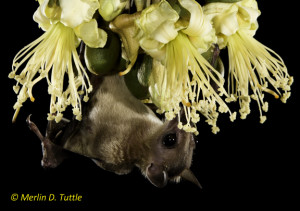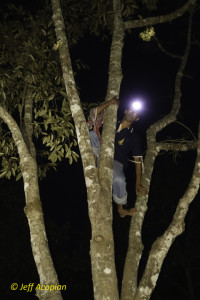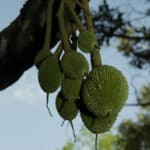Challenging torrential rains countered by cooperative bats in Costa Rica
Merlin and MTBC team members spent 19 days in Costa Rica last November on a filming trip for “Bat City” with its Director and Emmy

Dr. Sara Bumrungsri, a leading bat ecologist, invited us to help document the essential roles of Cave Nectar Bats (Eonycteris spelaea) in pollinating some of SE Asia’s most ecologically and economically valuable plants near Hat Yai in Thailand’s Songkhla Province. We set up our bat photo studio in Sara’s lab at the Prince of Songkhla University, caught two cave nectar bats in mist nets set beneath durian flowers in an orchard, tamed them so they would go about their normal activities in Merlin’s enclosure, then brought them fresh flowers so he could photographically document their importance as pollinators.

Though it may sound easy, in reality it was extremely challenging. The flowers were often high up in trees and didn’t become fully open and loaded with nectar till well after dark. Fortunately, Sara was an expert tree climber, having practiced climbing coconut palms as a youth. He and his graduate student, Tuangit Sritongthuay (nick-named Fon) pitched in to help find and obtain flowers, and our volunteer helper, Jeff Acopian and I took turns sitting up with Merlin till 3 to 5 AM, helping organize flowers into sets indistinguishable from what one would see if photographing them in a tree top, which of course is impossible. Often we’d have to sit perfectly still for an hour or more at a time between bat visits through seemingly endless nights.

Merlin is never satisfied till he has several near perfect pictures in which the bat is not only clearly seen pollinating the flower, but is also in a cute pose. Often flowers are good for only a few quick visits before they wilt, and if a bat approaches from the wrong direction it may get all the nectar and pollen with what Merlin disgustedly refers to as “butt shots” being the only photos possible.

The story we came to tell involves the vital, but often misunderstood roles of Cave Nectar Bats as pollinators. Though durian fruits sell for billions of dollars annually in SE Asia, only a few growers actually understand the essential contributions of bats, mostly cave nectar bats. Some durian farmers even kill the very bats that pollinate their crops. They see flower petals and anthers falling to the ground soon after bats visit and mistakenly conclude that the bats are harming their flowers! By dropping no longer essential parts of flowers, durian trees are likely helping bats find those that haven’t yet been pollinated.
Love our content? Support us by sharing it!
Merlin and MTBC team members spent 19 days in Costa Rica last November on a filming trip for “Bat City” with its Director and Emmy
“Just like the old days, eh Heather?” Kent softly clicks his tally counter as he sits in his folding chair on the other side of
Bats can use sounds in many complex ways. They can sing and even have different dialects… When imagining a bat, the first thoughts that come
It was a long road to Austin, Texas. More than five years after my first introduction to Merlin Tuttle’s Bat Conservation as a teenager, I packed
2024 © Merlin Tuttle’s Bat Conservation. All rights reserved.
Madelline Mathis has a degree in environmental studies from Rollins College and a passion for wildlife conservation. She is an outstanding nature photographer who has worked extensively with Merlin and other MTBC staff studying and photographing bats in Mozambique, Cuba, Costa Rica, and Texas. Following college graduation, she was employed as an environmental specialist for the Florida Department of Environmental Protection. She subsequently founded the Florida chapter of the International DarkSky Association and currently serves on the board of DarkSky Texas. She also serves on the board of Houston Wilderness and was appointed to the Austin Water Resource Community Planning Task Force.
Michael Lazari Karapetian has over twenty years of investment management experience. He has a degree in business management, is a certified NBA agent, and gained early experience as a money manager for the Bank of America where he established model portfolios for high-net-worth clients. In 2003 he founded Lazari Capital Management, Inc. and Lazari Asset Management, Inc. He is President and CIO of both and manages over a half a billion in assets. In his personal time he champions philanthropic causes. He serves on the board of Moravian College and has a strong affinity for wildlife, both funding and volunteering on behalf of endangered species.